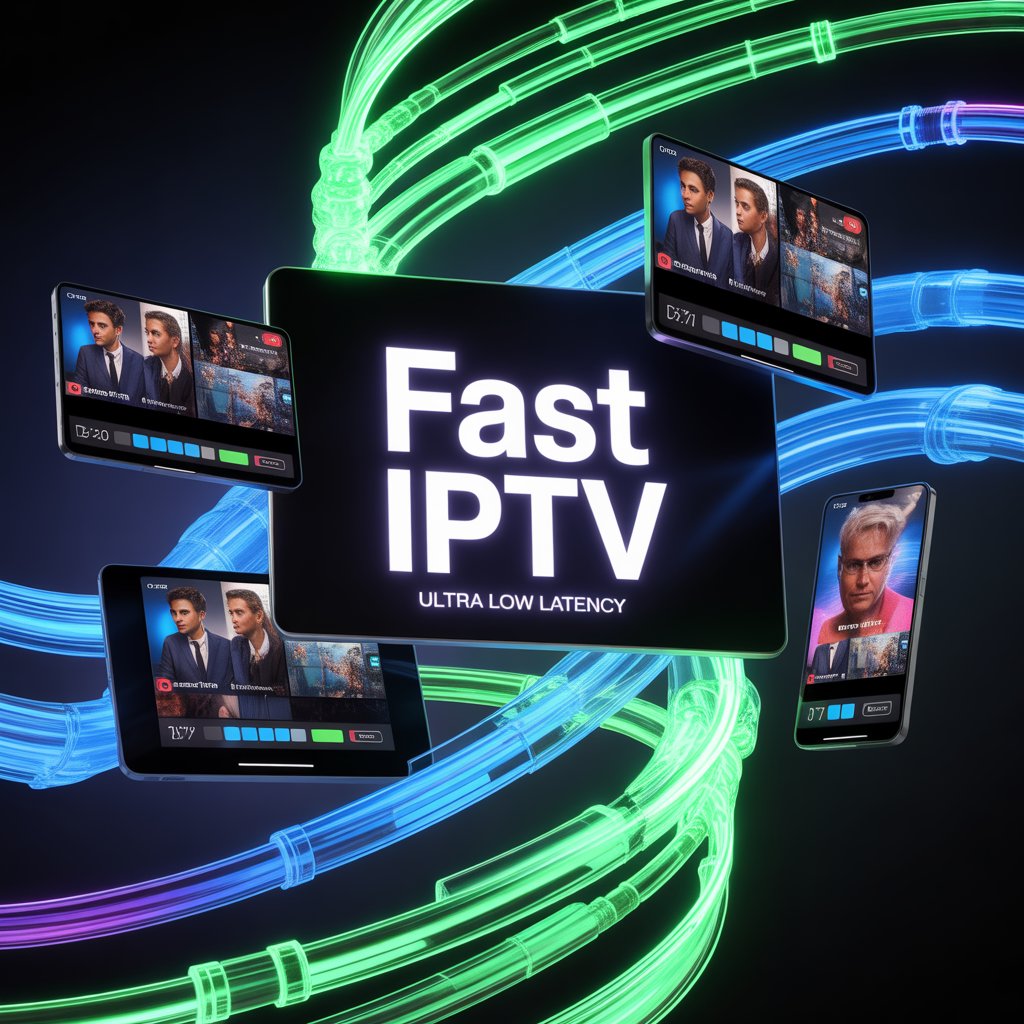low latency IPTV

Low latency IPTV means delivering live TV over IP with minimal delay between source and viewer — often targeted at sub-5 seconds or less — enabling real-time experiences for sports, interactive broadcasts and enterprise streaming.
Low latency IPTV is essential when immediacy matters: think live sports where every second counts, interactive events that need timely audience feedback, and enterprise town halls that must reach staff in near-real-time. This guide explains what low latency IPTV means, the technologies that enable it, practical deployment steps, common pitfalls, and how to choose or test a solution for your needs.
Throughout this article you’ll find best practices, checklists, and keyword-rich guidance for content creators, IT teams, and streaming professionals who need to reduce delay without sacrificing quality.
Why Low Latency IPTV Matters
Latency — the delay between the live action and what a viewer sees — shapes audience perception. Standard streaming can add 10–30+ seconds of delay. Low latency IPTV reduces that lag, improving viewer satisfaction and enabling real-time interactivity.
Scenarios where low delay is critical
- Live sports and betting — viewers expect near-instant replays and scores.
- Interactive broadcasts — polls, quizzes, and live Q&A must align closely with the broadcast.
- Enterprise communications — company news, alerts, and town halls benefit from minimal lag.
- Remote education and telemedicine — timely delivery improves engagement and safety.
What Constitutes “Low Latency” in IPTV?
There’s no universal threshold, but industry aims typically fall into categories:
- Sub-second to 2 seconds: achieved with protocols like WebRTC in controlled environments.
- 2–5 seconds: a common target for LL-HLS or LL-DASH deployments that balance scale and low delay.
- 5–10 seconds: still acceptable for many live broadcast experiences; better than typical HLS but not ultra-low.
When selecting or designing a system, define your target early — whether sub-2 seconds for interactive apps or sub-5 seconds for live sporting events.
Core Technologies Behind Low Latency IPTV
Delivering low latency IPTV requires optimization across the entire streaming chain: capture, encode, transport, CDN/edge, player and device. Breaking a single link often increases delay.
Encoding & transport
Low latency encoders tune GOP structure, slice sizes and keyframe cadence to reduce wait times. Transport protocols such as WebRTC, SRT, LL-HLS and LL-DASH are designed to minimize buffering and round-trip delays.
Network & CDN strategy
Minimising hops, using edge nodes near viewers, and choosing adaptive CDNs are essential. Multicast or optimized distribution in managed networks can further reduce delay for large audiences.
Player and client optimizations
The player must support short segment sizes, low buffer thresholds and quick manifest refresh intervals. If the set-top box or app uses excessive buffering, even the fastest network won’t help.
Benefits of Implementing Low Latency IPTV
Adopting low latency IPTV yields measurable gains across user experience, engagement and business outcomes:
- Real-time viewing: viewers experience near-instant content delivery.
- Increased interactivity: live polls, betting, and synchronous second-screen features become viable.
- Competitive differentiation: broadcasters offering lower delay can attract audience and advertisers.
- Reduced social spoiler effect: viewers are less likely to see results on social media before the stream.
Common Challenges & Practical Mitigations
Achieving low latency introduces trade-offs. Below are the common obstacles and proven mitigations.
Client/device buffering
Problem: Devices add buffering for stability, increasing delay.
Fix: Use low-latency capable players and configure smaller buffer thresholds and faster decode paths.
Network variability
Problem: Public internet adds jitter and packet loss.
Fix: Use CDNs with edge presence, enable forward error correction, or use protocols like SRT that tolerate packet loss better.
Scaling to many viewers
Problem: Low latency at scale requires extensive edge capacity.
Fix: Use a CDN with low-latency streaming features, leverage regional edge caching, or architect multicast in managed networks.
Quality vs latency tradeoffs
Problem: Ultra-low latency may reduce time for complex encoding or multi-pass quality improvements.
Fix: Define acceptable quality thresholds, use modern encoders that balance speed and efficiency, and monitor QoE metrics.
How to Choose or Deploy a Low Latency IPTV Solution
Whether you’re a broadcaster, an enterprise IT manager, or a developer, follow this checklist to evaluate options:
- Define latency targets: sub-2s, sub-5s, or sub-10s — document the SLA.
- Inspect supported protocols: confirm LL-HLS, LL-DASH, WebRTC, SRT support as needed.
- Check encoder specs: look for hardware/software optimized for low latency.
- Test devices: verify set-top boxes, smart TVs, mobile apps and web players under real conditions.
- Run load tests: simulate peak concurrent viewers, channel switching (zap time), and varied network conditions.
- Verify CDN/edge footprint: ensure edge nodes are near your audience and support low latency streaming.
- Measure and monitor: implement end-to-end latency metrics, buffer event logging and QoE dashboards.
Include internal test plans and timeline in your deployment documents. Use [Link to related article on streaming infrastructure] as a placeholder for more internal content references.
Use Cases Where Low Latency IPTV Shines
Typical applications that benefit from low latency IPTV:
- Sports broadcasters delivering live matches and commentary.
- Interactive TV shows with live voting or real-time audience participation.
- Corporate communications for urgent announcements and staff interactions.
- Virtual events and webinars where Q&A timing matters.
- Education and telehealth for timely two-way interaction.
SEO & Content Strategy for “Low Latency IPTV”
When creating content or landing pages about low latency IPTV, follow these SEO best practices:
- Include the exact keyword in the H1 and within the first 100 words.
- Use variations and synonyms in H2/H3 headings: e.g., “real-time IPTV streaming”, “low delay IPTV service”.
- Keep paragraphs short (2–4 lines) and include lists for skimmability.
- Add internal and external credible link placeholders: e.g., [Link to related article on streaming infrastructure] and [Link to WHO report on mental health].
- Place the keyword in meta tags and alt text for images (if present).
For an 1800+ word post, target keyword density between 0.8%–1.5% by naturally repeating the phrase low latency IPTV across headings and body text. Avoid forced repetition.
Best Practices & Operational Tips
Practical actions to keep latency low and experience stable:
- Monitor end-to-end latency and show trends over time.
- Tune segment/fragment lengths for chunked streaming to be shorter.
- Enable fast manifest updates for LL-HLS/LL-DASH or use WebSocket signaling where appropriate.
- Use adaptive bitrate wisely — rapid switches can increase perceived latency.
- Prefer players and decoders that expose low buffer modes to clients.
- Test channel change (zap) times — make menus and guides responsive too.
- Document fallback modes for devices or networks that can’t reach low latency targets.
Pitfalls to Avoid
Common mistakes teams make when chasing low latency IPTV:
- Relying on default HLS settings — long segment durations increase delay.
- Not validating device compatibility — some clients ignore low buffer hints.
- Neglecting network diagnostics — spikes and loss will undermine any low latency gains.
- Forgetting user experience — extremely low latency with poor quality is not a win.
Future Trends for Low Latency IPTV
Expect broader adoption of LL-HLS, LL-DASH and WebRTC. Edge computing, improved congestion control, and smarter players will help deliver higher resolution live streams with consistently low delay.
Interactive, synchronized second-screen experiences and real-time commerce integrations will drive more investment into low latency delivery.
Quick Deployment Checklist
- Define your target latency and acceptable tradeoffs.
- Select protocols and encoders that support your target.
- Validate CDN edge presence and test under load.
- Test across real devices and networks (mobile/desktop/CTV).
- Implement monitoring: latency, buffer events, bitrates, QoE.
- Document fallback flows and user guidance for suboptimal networks.
Resources & Further Reading
Curate credible external resources and internal guides as you build expertise:
Conclusion
Low latency IPTV transforms how live content is experienced — making broadcasts more immediate, interactive and engaging. By understanding the end-to-end chain, selecting appropriate protocols and testing thoroughly, you can deliver a superior live streaming experience that meets audience expectations.
Next steps: run a pilot with clearly defined latency goals, measure end-to-end metrics, and iterate. Need help? Contact our team for a tailored low latency IPTV assessment.
Subscribe for deeper technical guides or request a consultation